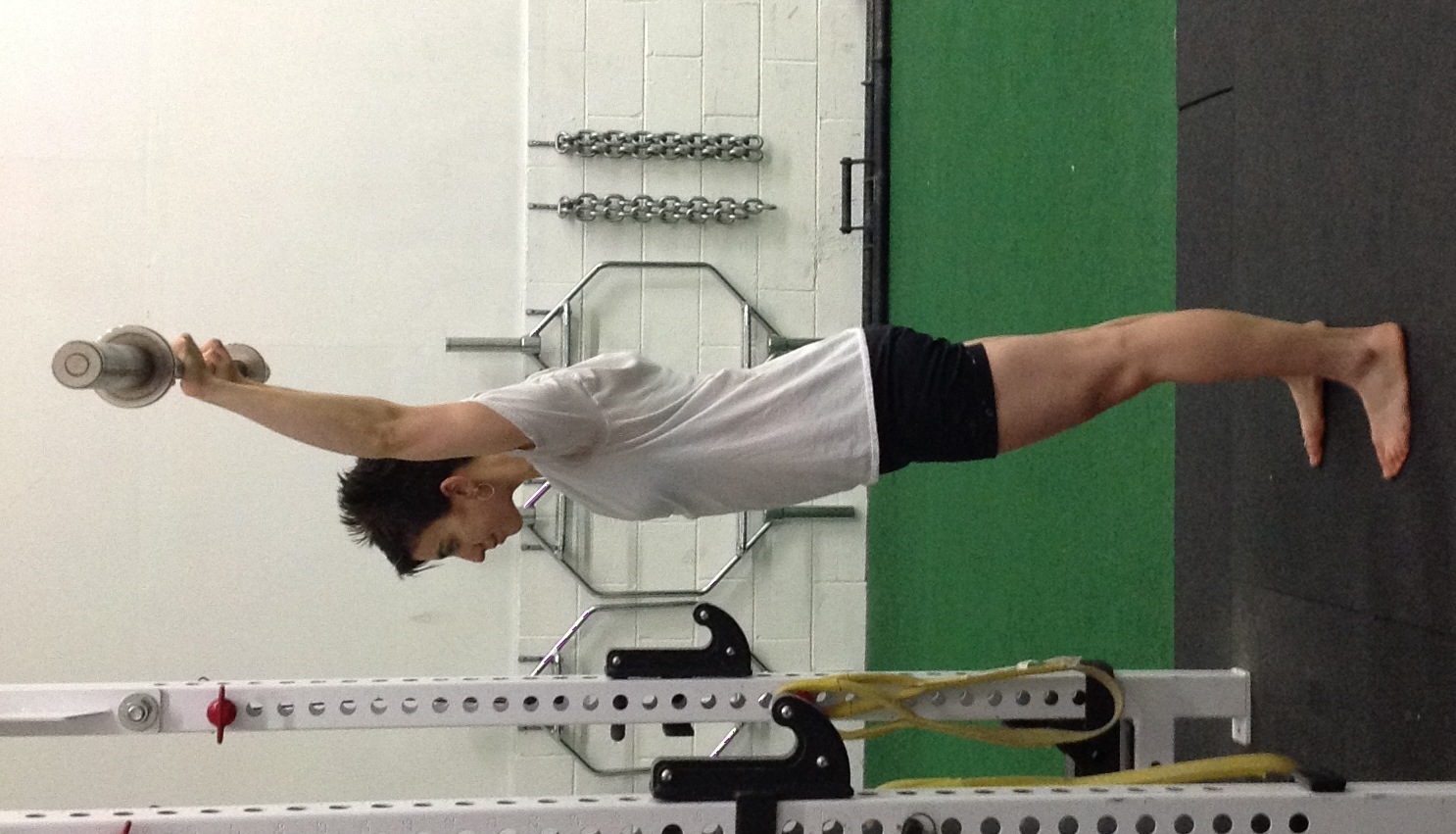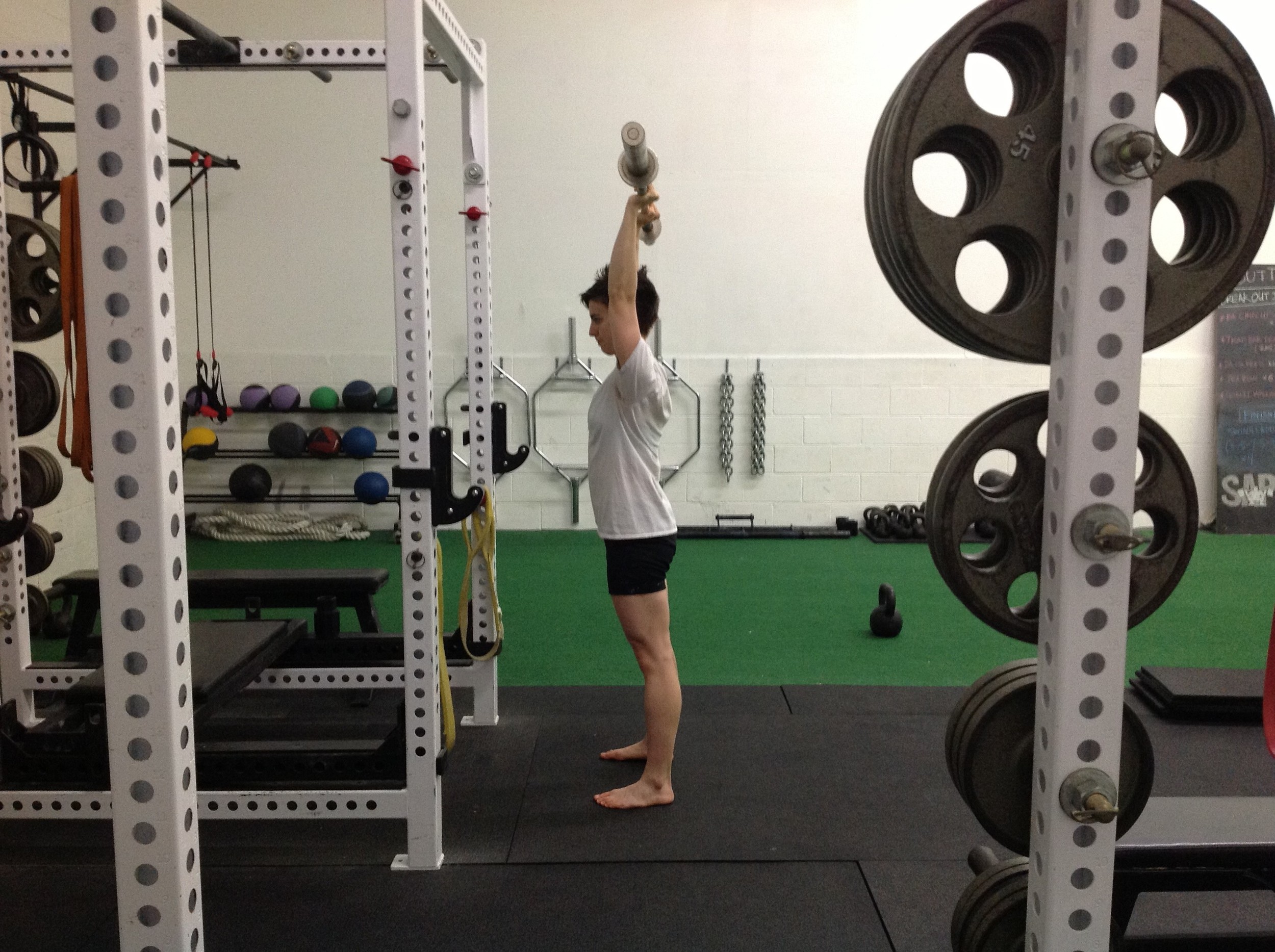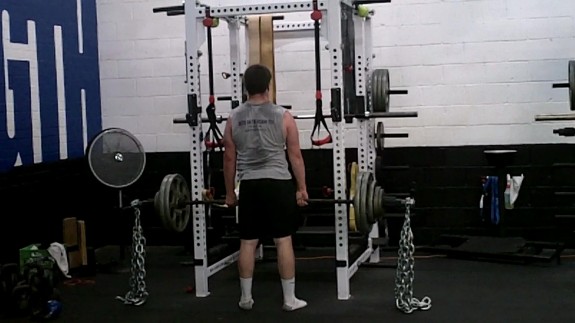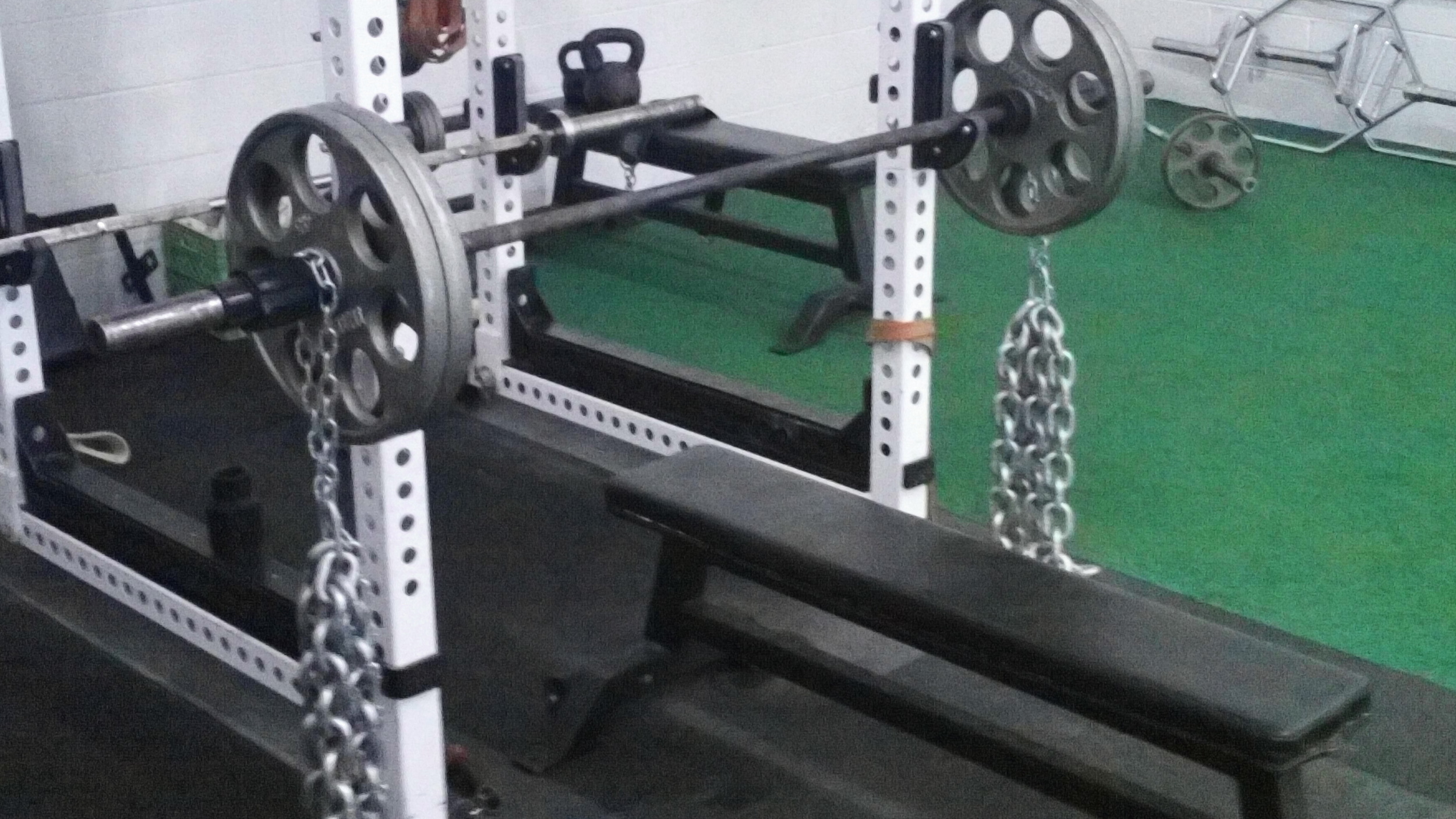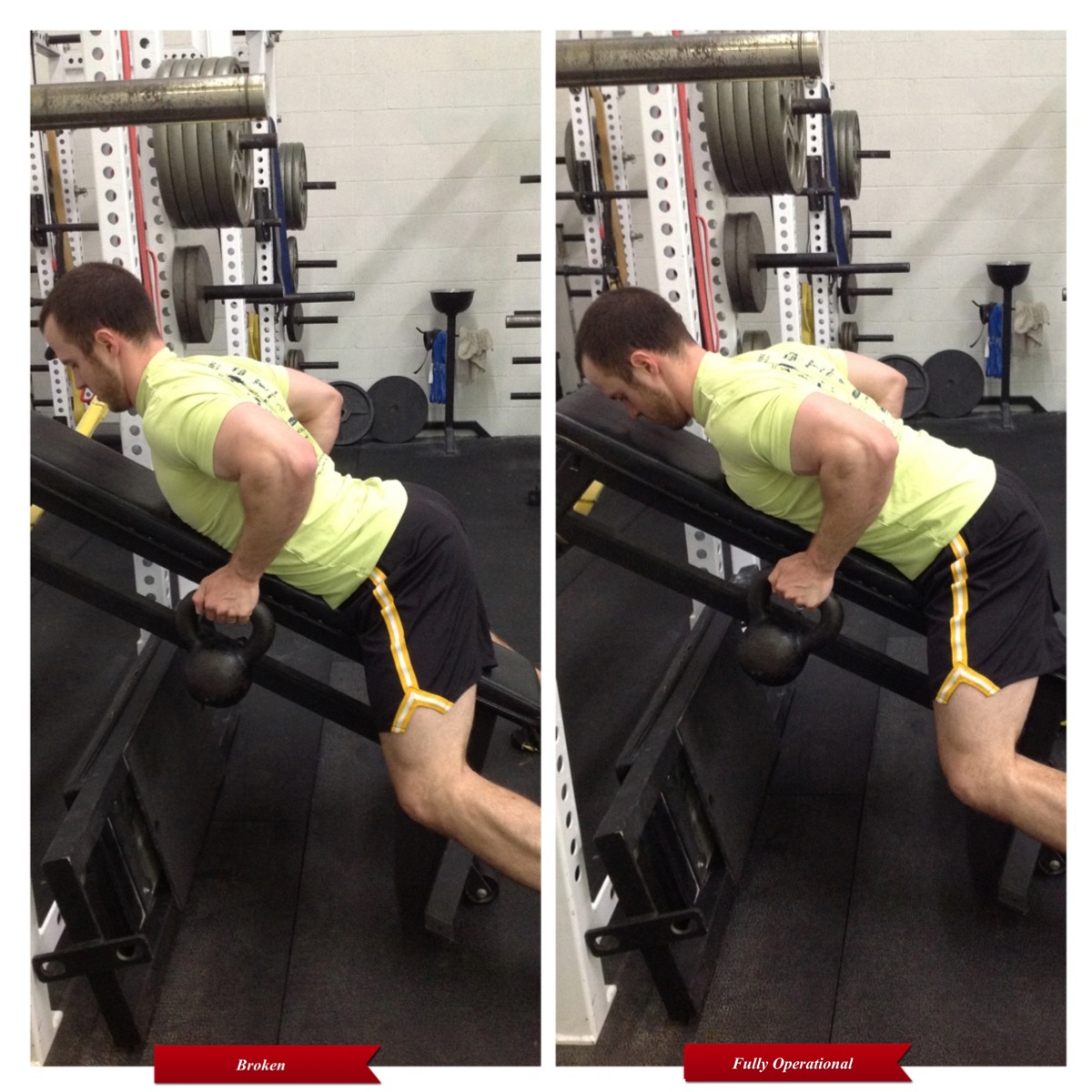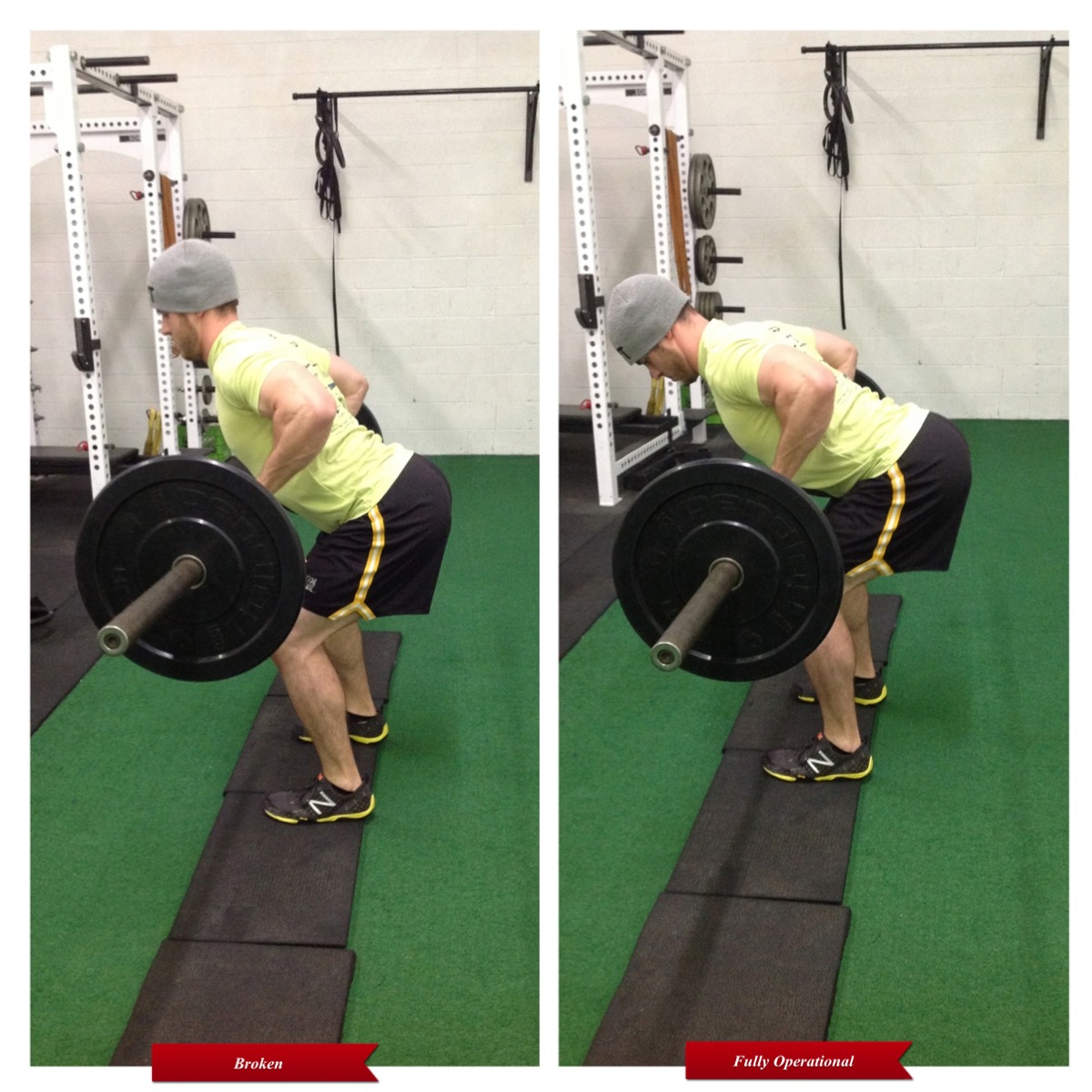Friday Musings 1/18/13: Coaching the Overhead Press, Deadlift Program, Tying the Perfect Tie
No, it is indeed not Friday at the time of posting this....decided to do this round a day early.
1. Coaching the Overhead Press
There's something intrinsically satisfying about pressing a heavy weight overhead, not to mention the host of benefits it provides, provided you don't butcher it. I actually did a little Q & A on overhead pressing HERE, for those interested. Moving on...
A cue often given in the overhead press is to "push the head and body through" at the top, the goal here being to prevent the bar from drifting too far away from the body. However, I often see people woefully abuse this cue to the extreme and jut their head way too far out at the top, slipping into gross extension, especially at the cervical spine:
Those of us coaches in the crowd often experience profuse bleeding of the cornea when we see people perform a pushup with the oh-so-prolific forward head posture, so why is does it all of a sudden become a different ball game when we press vertical instead of horizontal? You can see, if I flip the above picture of Kelsey 90 degrees, where she would be in the horizontal plane:
Not a pretty "pushup" position, right?
Yes, you do want to prevent the bar drifting away from the midline of the body, but be sure to keep the head neutral - aka a packed neck - as you finish the lift at the top:
When we jut the head forward, all we essentially wind up doing is cranking on that levator scapulae - thus cementing a downward scapular rotation pattern (not ideal) - and substituting forward head posture for actual scapular upward rotation and posterior tilt, anterior core stability, shoulder flexion, and T-Spine extension.
Translation: Shoving the head forward turns you into a walking ball of fail.
Keep those glutes tight, abs engaged, ribcage down, and ideally you'll want a vertical line going through the bar, ears, and midfoot when at the top of the press.
2. High Frequency Deadlifting
Back in 2012 I wrote a post called A Little Deadlift Experiment, Part 1, in which I briefly discussed a high-frequency deadlifting plan I used to add 40 pounds to my deadlift in 4 weeks. I never ended up writing Part 2 (yes, fail on my part), but I received a number of questions, both on the blog and through email, on how it ended up.
Well, I actually only ended up doing it for another month, but I did add another ten pounds to my total during that month. Excellent. I stopped it due to the pursuit of a few other goals, but I did want to share that I've "experimented" with the program on other people and it has worked wonders.
Mark - one of my buddies, and a physical therapist - called me up last year year telling me he made a bet with his supervisor that he could eventually deadlift over 400lbs. The kicker? He only had about 4 months to do it, his deadlift 1RM was sitting right around 300lbs, and he made the dreaded Alpo Bet, a la Dan John. So he called me in hopes I could help him add 100lbs to his deadlift in a matter of a few months.
Great.
After berating him on the phone for making me responsible to help him win an absurd bet he never should have made, I gave him the very deadlift program I used.
The result? His deadlift shot up from 300lbs to 435lbs in a matter of five training cycles, leaving him the winner of the bet and relieving him from eating a can of Alpo in front of his supervisor. What?!
Keep in mind, he had over three years of solid lifting experience under his belt, so these weren't newbie gains, either.
Note: All the credit goes to Mark on this one. He worked his tail off - despite the fact that he has a very demanding schedule and was undergoing some significant "life" changes - and trusted me every step of the way with the seemingly asinine program I gave him.
I'm not going to share the program here yet though, as I may end up using it for future article or online program. Patience, patience....
3. Tying the Perfect Tie
This one's for you gents in the crowd.
Maybe I'm a bit of an anomaly here, given that I'm fortunate enough to wear t-shirts and athletic shorts to work each day, but getting ready for an event requiring a tie can be exceedingly frustrating. (Yes, you office workers in the crowd, go ahead and shake your heads in reproach, I realize I have it easy.)
Fortunately, Tim Ferriss seems to be an expert at doing any and every random task extraordinarily well, and tying ties is no exception. Here is a quick, extremely useful video on how to tie the perfect tie, every time.
It can take a couple tries, but once you get it, you're golden. Ever since employing this tactic I've been able to boast the best tie in the room at formal events. What what!
I've run out of musings for the time being, hope everyone has a great weekend.
10 Things I'd like to Share from 2012
As I opened my computer this morning, it didn't take long to realize I had a list of non sequiturs running around my brain. As 2012 is drawing to a close, why not allow them to run around on paper, forming a random thoughts post. Here are 10 things I either remembered, learned, or simply felt like sharing from the past year: 1. Taking the time to teach an athlete to "sit into the hip" during the foundational phases of jump training in the frontal and transverse planes will do wonders for their athletic development, as they progress onward to more "advanced" stages of change-of-direction training and force transfer outside of the sagittal plane.
Notice how in the video above, I use a "soft knee" during each landing and and push my hips back to decelerate. This displays the proper utilization of the glutes and other active restraints of the hip to create "tri-planar" stability: eccentrially controlling flexion, internal rotation, and adduction of the femur upon each ground contact.
However, the video below shows how you'll typically see people perform lateral hurdle (or cone) hops. Note how I rely much more heavily on the passive supports of my body - namely, ligaments, menisci, and other joint structures - to decelerate each landing.
Many athletes will land with a "double step," or even fall over, when learning how to decelerate correctly for the first time. Investing ample time in mastering this entry-level progression will pay huge dividends later on within the realm of injury risk reduction, change-of-direction speed, and rotational power on the field.
2. I love coffee, and, as a result, one of the best parts of my day (other than a good poop) is preparing and enjoying a quality brew early in the morning. Either that, or visiting my favorite local coffee shop, Caffe Amouri, where I settle down to do computer work alongside my faithful squire, Aragorn.
The best decision I made this past year to enhance the morning experience of home-brewing coffee was to purchase a Clever Dripper to prepare my morning elixir. Some of you may recognize it as the "pour over" or "hand pour" method.
With it, you receive all the benefits of a french press - full extraction of the flavors and sugars of the bean - but without the "mud" that typically resides at the bottom of a the mug. The Clever Dripper also WAY easier to clean than a french press.
I highly recommend it for you coffee-lovers in the crowd.
3. Here's an important classification I like to use for differentiating between main lifts in and accessory lifts in program design: Any main movement can also used as an accessory movement, but not all accessory movements can necessarily be a main movement.
It may sound simple and borderline obvious, but it bears repeating for those that are unsure of how to set up their programs.
4. The wrong and right way to hip hinge during a squat. Be careful of overemphasizing the familiar "hips back" cue too much when either squatting yourself or teaching someone else how to squat, especially if an anterior-loaded squat pattern like a goblet squat or barbell front squat is being performed.
If you push your butt back too much at the start, then your body has nowhere to go but forward on the way down in order to find its center of gravity with respect to the bar position. I think it goes without saying that this is unfavorable, with regards to both safety and that whole getting stronger thing.
See the video above for a brief demonstration of what I'm referring to. The first two reps show what happens when you overdo the hip hinge at the start, and the third and fourth rep show how to properly push your hips back as you descend to the bottom.
5. I read through the Harry Potter series this year (yes, admittedly it was fantastic), and jotted down some memorable lines as I went along. Here are a few of them:
- "Indifference and neglect often do much more damage than outright dislike." ~ Dumbledore
- "If you want to know what a man's like, take a good look at how he treats his inferiors, not his equals" ~Sirius Black
- "It does not do to dwell on dreams, and forget to live." ~ Dumbledore
6. Speaking of literature, I'm currently reading A Game of Thrones, and it is spectacular, to say the least. The author, George R.R. Martin, does a phenomenal job of reeling you into the story relatively quickly, and the world he creates is a different than most fantasy stories in that he veers away from the typical character archetypes (few are totally good or wholly evil, you don't have the classic hero who overcomes impossible odds and is immune to corruption, etc.) and he breaks many of the "rules" of stereotypical fantasy.
Hint: Don't read it if you're afraid of your favorite and/or likeable characters to die.
Not to mention, Martin is an absolute master of metaphors, description, and overall wordplay. Read it, and thank me later.
And, while I've heard good things about the HBO series, it still doesn't count. Sorry. However, that still doesn't mean this picture is not awesome:
7. One of the most rewarding parts of my job, by far, is helping people to train around injuries. It's extremely humbling to have the opportunity to help countless individuals - be they just coming out of surgery or simply dealing with a "tweaked" ankle or knee - continue to get stronger despite an injury they recently received.
Below is a video of Conrad, a 64-year-old who recently underwent not his first, but SECOND, total knee replacement surgery within the past year. Instead of wallowing in misery over the fact he couldn't do lower body training for a while, he barged through the doors of SAPT, with a battering ram, asking us to prepare him for a powerlifting meet. Keep in mind this was just weeks after his total knee replacement.
We put him on a bench-specialization program, and the end result was him hitting a bench PR in an official meet.
He serves as such a great example to those - way younger than 64 years of age, mind you - who make excuses as to why they seemingly can't take time to care for their bodies.
8. The Hobbit was an excellent film. I honestly don't see how Peter Jackson, or anyone for that matter, could have possibly done a better job with it. Yeah, people are upset he's splitting it up into three parts, but to me that just shows how Jackson pays attention to detail, and wants to ensure they leave no stone unturned during the film. It also means we still have two more excellent experiences in the theater to look forward to around Christmastime.
I didn't want to read any of the reviews before I saw it, so I looked at them a couple days after seeing the movie. Upon reading just a few of them, it confirmed my notion that the opinions of movie critics are worthless and overrated.
9. When you set up for the basic plank (and its variations), choosing to go from the "bottom up" vs. the "top down" actually has significant impact on how much iliopsoas is recruited. Considering that heavy recruitment of the iliopsoas is generally unfavorable in core stability exercises, try setting up from the bottom up rather than the top down.
10. An admittedly strange and ungrounded pet peeve of mine is when people use the words "jealous" and "envy" interchangeably in conversation. They don't mean the same thing!
To clear the air: Envy generally implies a sense of covetousness or a desire for something that someone else has. Jealousy, on the other hand, relates to a sense of resentment due to rivalry or the fear of being replaced.
I readily admit I don't have grounds from which to stand upon this sense of annoyance, as I am far from a grammar expert myself, and I make grammatical errors all.the.time. but for whatever reason I can't get this one out of my head.
Note: If you enjoyed this list format, feel free to check out this post or this post that I wrote in 2011.
An Overuse of the "Arch Your Back" Cue, and How to Create Better Positioning During Your Lifts
"Pull your chest through.""Stick your chest out." "Put your shoulder blades in your back pocket." "Arch your back....I said, ARCH!"
If you've ever set foot in the weight room, I bet you've heard at least one of the above verbal cues spat out hundreds of times by a coach or trainer in the middle of teaching someone to lift weights.
And for good reason, considering that this is what I usually see when I watch the average gym-goer set up to perform a deadlift or row:
Not pretty, right? And something that should make you want to throw your face into an axe.
We know that lifting with a round back (flexion), at least in the lumbar region, is exceedingly dangerous, large thanks due to Dr. Stuart McGill and his research showing that repeated lumbar flexion, especially under load, is the exact mechanism for disc herniation.
So, what did we do as an industry? We took the stance that if lumbar flexion is bad, then we should keep people as far away from that as possible. If extending (arching) your back is good, then the more the better, right? This thought process lead to us ensuring that everyone "arched their back," or "pulled their chest through" as much as humanly possible anytime they set up to perform a deadlift, row, squat, you name it.
Guess what? Excessive extension is bad, just as excessive flexion is bad.
Overextension in the lumbar region can be just as evil as flexion. What shows up on your doorstep when you do it for too long? Hellooo to low back pathology, to spondy and her cousins. Hello to facet irritation. Hello to an even greater anterior pelvic tilt. Hello to crazy stiff lats and a weak anterior core. Hello to literally cranking on the passive restraints of your back (not a good thing). Goodbye to stronger lifts.
Below is a bevy of comparisons I've put together, showcasing what is commonly seen as good form (sticking your chest out, or overarching your back), alongside a picture of what your back should look like. The pictures on the left show broken, ugly positioning while the pictures on the right display stable and sound positioning.
Instead of performing our lifts with a hyperextended spine, we want a neutral spine. A neutral spine is a happy spine.
TRX Row
Seated Row
Chest-Supported Row
Bent-Over Row
Anti-Rotation Press
Bent-Over Barbell Row
Goblet Squat (Top)
Banded W
Deadlift (Middle)
It may surprise some of you to see what you may have initially thought of as good form, to actually be broken. And knowing how to cue neutral spine is of even greater importance when you're working with someone with extension-based back pain, or even an athlete who lives and breathes in an extended posture.
And it's no wonder why you see so many ugly internet videos of people performing high rep snatches, with the top of each one looking something like this:
When we have crazy stiff lats and a weak anterior core from performing everything in extension, it's no wonder why so many of us look like utter poo poo when we go overhead.
Closing Thoughts
- Telling someone to arch their back or stick their chest out isn't always a bad thing, you just have to use discernment as to when to use it. Some people - i.e. desk jockeys or those with very kyphotic postures - may actually need to extend their back as much as they possibly can, just to get to neutral! These are the folks you may find yourself cueing "chest out," "arch your back" over and over again to help them get out of flexed (rounded) posture into neutral, and, depending on the population you work with, you may in fact find this scenario way more common than the reverse (those who shoot way past neutral into hyperextension).
- For those with flexion-intolerant back pain, it can be O.K. to cue a minor bit of extension during core stability exercises, lunge variations etc. just to drive a bit of intended extension and help them get out of the flexed posture they sit/stand in.
- It's kind of ironic that fitness professionals always freak out about anterior pelvic tilt, and yet the way we we've been cueing exercises have only exacerbated the issue! We bang ourselves against the wall when we stretch our hip flexors into oblivion and then go right into a deadlift or glute bridge with a hyperextended spine.
- The captions "broken" and "fully operational" in the pictures above are references, of course, to the different statuses of the death star ray gun in The Return of the Jedi.
Common Exercise Corrections: Pain in The Knee During Lunging
Installment numero three-o in the common exercise fix series. To recap: 99% of the time it's not the exercise, it's the execution that's causing issues.
So, let's say you're doing a split squat, step back lunge, forward/walking lunge or some other lunging variation that I forgot to mention and, oh bugger, your knee hurts.
If you have pain in the front knee...
- Check your shin angle. If it's not perpendicular to the floor... then you probably are experiencing pain in the front of your knee.
Look at that shin!
- Check your variation. Some folks just can't do forward-moving lunges. Switch to a reverse lunge (above) or split squat variation, thus minimizing the sheer force on the knee (also, of course, maintaining that vertical shin).
- Still having problems? Check how you're applying force through your foot. (Sorry, that was an awkward sentence) Are you pushing through the ball of your foot to stand up or your heel? Pushing through your heel will put the stress of standing up on your glute (instead of the quad) and your glutes are a LOT better at producing hip extension than your quads. Matter of fact, think about pulling yourself upright through your heel as you stand up. (This applies to step-ups too.)
If you have pain in the back knee...
- Check your back leg's placement. Are you in line or is the back leg at a goofy angle? You want to stand about hip-width apart and make sure that your knee is going straight down (instead of in or out at an angle). How does one create such a delightfully descending back knee? Squeeze your butt. It should straighten out any wild knees.
- Check your variation. Maybe switch to a lunge exercise that doesn't require the back leg to work as hard, a Bulgarian split squat, might work as you're not supposed to use the back leg as much.
Note* this has an ISO hold at the beginning of the set.
- Still hurting the back knee? Perhaps try a different single leg exercise such as a bowler squat, a single leg squat progression or single leg RDL. Those will help train the posterior chain (which might be the source of your knee pain, weak glutes or hamstrings) as well as your hip stabilizers (adductors, glute medii, quadratus lumborum) as it might be an instability in your hips that are causing the knee pain.
If, after trying all these fixers, your knees still hurt, well, don't do lunges (you're in the percentage of folks that just need to stay away from them). There are plenty of other single-leg exercises out there that are just as awesome!
Common Exercise Corrections: Lower Back Pain in Deadlifting and Squatting
I hope everyone fared hurricane Sandy safely! We"re so thankful that worst of it bypassed the DC area!! Thoughts and prayers go out to those in NY and NJ which seemed to have brunt of Sandy"s fury poured out upon them!
Secondly, a GINORMOUS congratulations to the following SAPT ladies who made the all-district volleyball teams:
1st team- Caitlyn, Eliza and Hannah
2nd team - Kenzie
Honorable mention- Clare, Maggie and Carina
Congratulations ladies!! All your hard work in here paid off!
Anyway, onward and upward. As stated in my previous corrections post, it"s usually not the exercise that"s causing pain, it"s the execution.
Today"s topic: Lower back pain/irritation during a squat or deadlift.
From the outside eye, everything looks great: Lower back is tight and has a slight arch, the upper back is stiff, the hips are moving back like they should... but there"s a niggling pain in the lower back. What gives?
This is a perfect example. Kerry looks pretty good for the most part, but she had a little bit of a pain in her lower back as she pulled. (thankfully she told me. Lesson to trainees: coaches, though we are Jedis, we can"t always tell if you"re having a pain. Speak up!) As was the case with Kerry, more often that not, the athlete isn"t bracing the abs or is not using the glutes as much as (s)he needed.
Solution:
- "Brace your abs like Now we’re back to college student credit cards based systems, pretty much the world over. you"re about to get punched" is a standard cue I tell athletes. We incorporate bracing drills, to learn proper bracing technique, but this cue will work in a pinch if the athlete hasn"t mastered bracing yet.
- "Start squeezing your glutes/cracking the walnut BEFORE you pull off the ground." (alternately, in a squat, I tell the athlete to "spread the floor with their feet" on the way down and the way up) This cue usually makes the athlete more aware of their glutes and helps them think about using them more. By activating the glutes BEFORE the pull, it acts like a primer button for a lawn mower, it gets the engine ready to work! When they glutes are doing their job well then there"s much less strain on the lower back musculature.
Again, there isn"t much visually that changed between the first and the second video, but Kerry didn"t have pain and the pull looked much more solid and confident.
So, if you have a nagging pain, brace and crack the walnut! 9 times out of 10 that will clear it all up!


